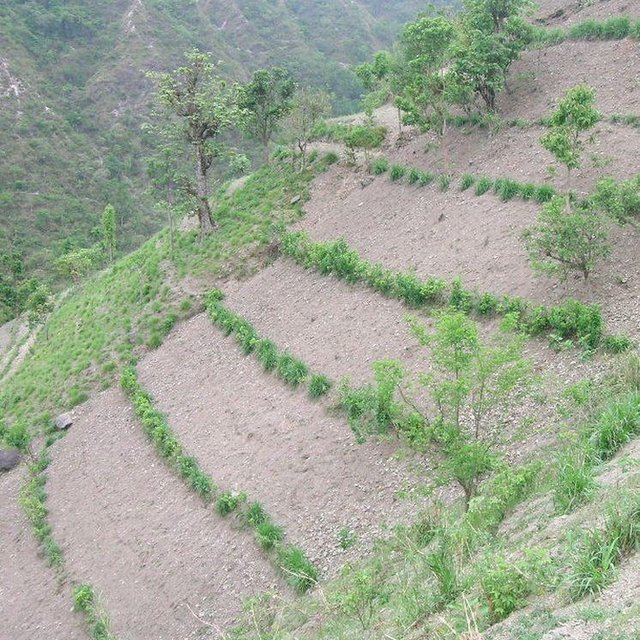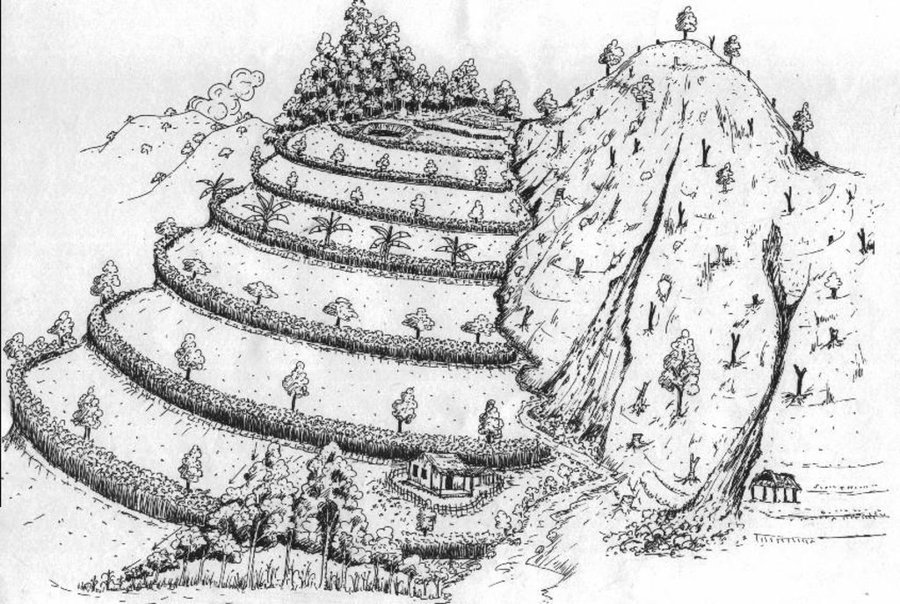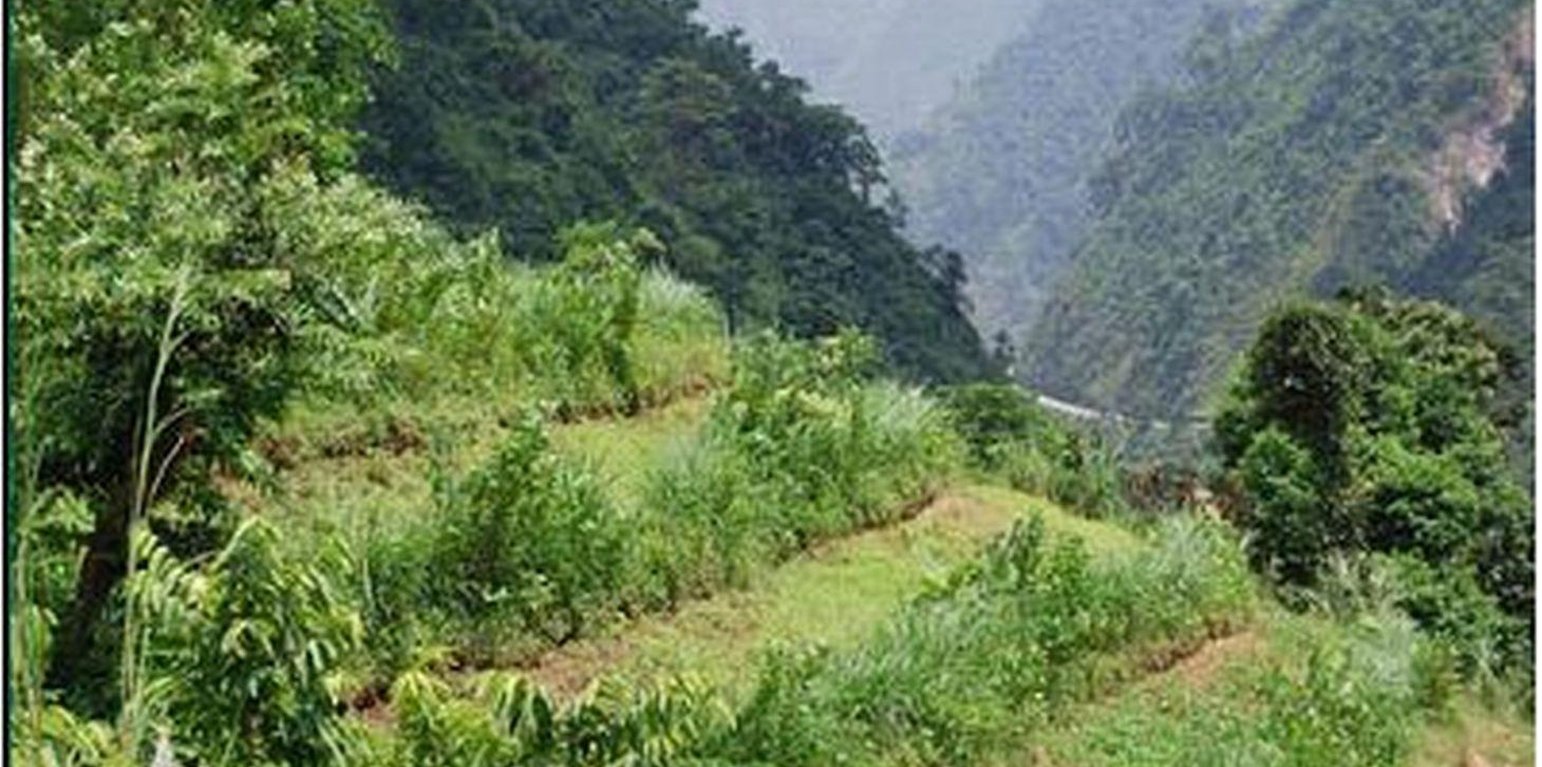Hedgerow technology
(Nepal)
Ghase har Prabadhi (Main Contributor: Gyanbandhu Sharma, LI-BIRD)
Descrição
A technology that uses hedgerows to help establish terraces on sloping land; farmers learn improved methods to manage a cultivation practice that stabilizes the soil, enhances food production, and adds to on-farm cash income.
Hedgerow technology provides options and opportunities for farmers working on sloping land. These hedgerows are a soil conservation measure but they also help to generate additional biomass and fodder and/or income for marginal farmers; in addition, they offer the added benefit of helping to balance the ecosystem and to address climate change by encouraging biodiversity. This improved version of a local technology makes maximum use of indigenous knowledge and adds to it by making available the latest scientific knowledge.
Purpose of the Technology: Farmers have traditionally selected plants for hedgerow cultivation based on practical considerations such as the availability of seeds and seedlings, how well seeds germinate, how well the plants grow and how well they can be coppiced, their branching habit, the amount of biomass they can produce, and how much cash the crop can generate. They made these choices without the benefit of any external input or scientific knowledge, relying solely on what they have been able to observe locally over the years. The participatory technology development process aims to help farmers by providing them with scientific input to augment their traditional knowledge on the selection, plan, and design of hedgerows. Over a very short time, the farmers learn to make good use of the new information and start enjoying the benefits that the improved agriculture yields in terms of social, economic, and environmental benefits.
Establishment / maintenance activities and inputs: The following steps outline how hedgerows can be established on sloping land:
• A participatory designing and planning process is used to choose which sloping lands will be cultivated and to select which hedgerow species are to be planted. Trained manpower is recruited with the help of farmers and other related stakeholders.
• The necessary materials such as A-frames, seeds, and seedlings are prepared.
• The technology is implemented in the field by trained manpower.
• The hedgerow seedlings are regularly maintained.
• The land users participate in periodic monitoring and evaluation of the technology. They report on progress and provide feedback.
Localização
![]()
Localização: Gorkha, Tanhun, Chitwan, Makwanpur, Nawalparasi, Dhading district, Nepal
Nº de sites de tecnologia analisados:
Geo-referência de locais selecionados
Difusão da tecnologia: Uniformemente difundida numa área (approx. 1-10 km2)
Em uma área permanentemente protegida?:
Data da implementação:
Tipo de introdução
-
atráves de inovação dos usuários da terra
-
Como parte do sistema tradicional (>50 anos)
-
durante experiências/ pesquisa
-
através de projetos/intervenções externas

Initial stage of establishing hedgerow technology on sloping land (Gyanbandhu Sharma)
Classificação da Tecnologia
Objetivo principal
-
Melhora a produção
-
Reduz, previne, recupera a degradação do solo
-
Preserva ecossistema
-
Protege uma bacia/zonas a jusante – em combinação com outra tecnologia
-
Preservar/melhorar a biodiversidade
-
Reduzir riscos de desastre
-
Adaptar a mudanças climáticas/extremos e seus impactos
-
Atenuar a mudanças climáticas e seus impactos
-
Criar impacto econômico benéfico
-
Cria impacto social benéfico
Uso da terra
Uso do solo misturado dentro da mesma unidade de terra: Sim - Agrofloresta
-
Terra de cultivo
Número de estações de cultivo por ano: 2
Abastecimento de água
-
Precipitação natural
-
Misto de precipitação natural-irrigado
-
Irrigação completa
Objetivo relacionado à degradação da terra
-
Prevenir degradação do solo
-
Reduzir a degradação do solo
-
Recuperar/reabilitar solo severamente degradado
-
Adaptar à degradação do solo
-
Não aplicável
Degradação abordada
-
Erosão do solo pela água - Wt: Perda do solo superficial/erosão de superfície
-
Deteriorização química do solo - Cn: declínio de fertilidade e teor reduzido de matéria orgânica (não causado pela erosão)
Grupo de GST
-
Medidas de curva de nível
Medidas de GST
-
Medidas vegetativas - V1: cobertura de árvores/arbustos
-
Medidas de gestão - M1: Mudança no tipo de uso da terra
Desenho técnico
Especificações técnicas
Hedgerow technology on sloping land; note that the hedgerows help to stabilize the land and to control soil erosion and runoff.
Technical knowledge required for field staff / advisors: moderate
Technical knowledge required for land users: moderate
Main technical functions: control of dispersed runoff: retain / trap, Prevent Soil erosion
Secondary technical functions: reduction of slope angle, stabilisation of soil (eg by tree roots against land slides), increase in nutrient availability (supply, recycling,…)

Author: Bir Bahadur Tamang
Estabelecimento e manutenção: atividades, insumos e custos
Cálculo de insumos e custos
- Os custos são calculados: por área de tecnologia (tamanho e unidade de área: ha)
- Moeda utilizada para o cálculo de custos: USD
- Taxa de câmbio (para USD): 1 USD = n.a
- Custo salarial médio da mão-de-obra contratada por dia: 2.7
Fatores mais importantes que afetam os custos
The cost of implementing this technology is dependent on the gradient of the slope (and other geographical features), the local cost of the seeds or seedlings, and the availability of labour.
The technology has a low to average cost for implementation. Locally available seeds and seedlings and locally trained manpower and resources are valuable low-cost inputs for implementation. The technology has a higher likelihood of adoption in some social and physiographic areas, especially where land users can integrate their own expertise with scientific knowledge. Many factors play a role in determining whether the technology is effective and sustainable and whether farmers are willing to adopt it; these include that if the technology is demand driven, it is more likely to be adopted, and if land users can use inexpensive local resources they are more likely to try it.
All costs and amounts are rough estimates by the technicians and authors
Atividades de implantação
-
The equipment that is needed for planting is collected and prepared; this can include such things as A-frames, spades, and sickles.• The hillside where the technology is to be implemented is first cleaned and groomed to make way for the new hedgerows.• Contour lines are demarcated.• The seeds and/or seedlings are planted along the contour lines. (Periodicidade/frequência: None)
Estabelecer insumos e custos (per ha)
| Especifique a entrada |
Unidade |
Quantidade |
Custos por unidade (USD) |
Custos totais por entrada (USD) |
% dos custos arcados pelos usuários da terra |
|
Mão-de-obra
|
| Prepare and plant along the contour lines |
persons/day/ha |
10,0 |
2,7 |
27,0 |
100,0 |
|
Equipamento
|
| Tools |
ha |
1,0 |
32,0 |
32,0 |
100,0 |
|
Material vegetal
|
| Seedlings |
ha |
1,0 |
68,0 |
68,0 |
100,0 |
| Custos totais para a implantação da tecnologia |
127.0 |
|
| Custos totais para o estabelecimento da Tecnologia em USD |
127.0 |
|
Atividades de manutenção
-
The hedgerows are weeded and cleaned to discourage unwantedplants and pests.• Enrichment planting• The hedgerows are pruned and the clippings are mulched.• Manuring (Periodicidade/frequência: None)
Insumos e custos de manutenção (per ha)
| Especifique a entrada |
Unidade |
Quantidade |
Custos por unidade (USD) |
Custos totais por entrada (USD) |
% dos custos arcados pelos usuários da terra |
|
Mão-de-obra
|
| Maintenance of hedgerows |
persons/day/ha |
26,0 |
2,7 |
70,2 |
100,0 |
|
Material vegetal
|
| Seedlings |
ha |
1,0 |
34,0 |
34,0 |
100,0 |
|
Fertilizantes e biocidas
|
| Compost / manure |
ha |
1,0 |
20,0 |
20,0 |
100,0 |
| Custos totais para a manutenção da tecnologia |
124.2 |
|
| Custos totais de manutenção da Tecnologia em USD |
124.2 |
|
Ambiente natural
Média pluviométrica anual
-
<250 mm
-
251-500 mm
-
501-750 mm
-
751-1.000 mm
-
1.001-1.500 mm
-
1.501-2.000 mm
-
2.001-3.000 mm
-
3.001-4.000 mm
-
> 4.000 mm
Zona agroclimática
-
úmido
-
Subúmido
-
Semiárido
-
Árido
Especificações sobre o clima
Thermal climate class: subtropics
Inclinação
-
Plano (0-2%)
-
Suave ondulado (3-5%)
-
Ondulado (6-10%)
-
Moderadamente ondulado (11-15%)
-
Forte ondulado (16-30%)
-
Montanhoso (31-60%)
-
Escarpado (>60%)
Formas de relevo
-
Planalto/planície
-
Cumes
-
Encosta de serra
-
Encosta de morro
-
Sopés
-
Fundos de vale
Altitude
-
0-100 m s.n.m.
-
101-500 m s.n.m.
-
501-1.000 m s.n.m.
-
1.001-1.500 m s.n.m.
-
1.501-2.000 m s.n.m.
-
2.001-2.500 m s.n.m.
-
2.501-3.000 m s.n.m.
-
3.001-4.000 m s.n.m.
-
> 4.000 m s.n.m.
A tecnologia é aplicada em
-
Posições convexas
-
Posições côncavas
-
Não relevante
Profundidade do solo
-
Muito raso (0-20 cm)
-
Raso (21-50 cm)
-
Moderadamente profundo (51-80 cm)
-
Profundo (81-120 cm)
-
Muito profundo (>120 cm)
Textura do solo (superficial)
-
Grosso/fino (arenoso)
-
Médio (limoso, siltoso)
-
Fino/pesado (argila)
Textura do solo (>20 cm abaixo da superfície)
-
Grosso/fino (arenoso)
-
Médio (limoso, siltoso)
-
Fino/pesado (argila)
Teor de matéria orgânica do solo superior
-
Alto (>3%)
-
Médio (1-3%)
-
Baixo (<1%)
Lençol freático
-
Na superfície
-
< 5 m
-
5-50 m
-
> 50 m
Disponibilidade de água de superfície
-
Excesso
-
Bom
-
Médio
-
Precário/nenhum
Qualidade da água (não tratada)
-
Água potável boa
-
Água potável precária (tratamento necessário)
-
apenas para uso agrícola (irrigação)
-
Inutilizável
A qualidade da água refere-se a:
A salinidade é um problema?
Ocorrência de enchentes
Características dos usuários da terra que utilizam a tecnologia
Orientação de mercado
-
Subsistência (autoabastecimento)
-
misto (subsistência/comercial)
-
Comercial/mercado
Rendimento não agrícola
-
Menos de 10% de toda renda
-
10-50% de toda renda
-
>50% de toda renda
Nível relativo de riqueza
-
Muito pobre
-
Pobre
-
Média
-
Rico
-
Muito rico
Nível de mecanização
-
Trabalho manual
-
Tração animal
-
Mecanizado/motorizado
Sedentário ou nômade
-
Sedentário
-
Semi-nômade
-
Nômade
Indivíduos ou grupos
-
Indivíduo/unidade familiar
-
Grupos/comunidade
-
Cooperativa
-
Empregado (empresa, governo)
Idade
-
Crianças
-
Jovens
-
meia-idade
-
idosos
Área utilizada por residência
-
< 0,5 ha
-
0,5-1 ha
-
1-2 ha
-
2-5 ha
-
5-15 ha
-
15-50 ha
-
50-100 ha
-
100-500 ha
-
500-1.000 ha
-
1.000-10.000 ha
-
> 10.000 ha
Escala
-
Pequena escala
-
Média escala
-
Grande escala
Propriedade da terra
-
Estado
-
Empresa
-
Comunitário/rural
-
Grupo
-
Indivíduo, não intitulado
-
Indivíduo, intitulado
Direitos do uso da terra
-
Acesso livre (não organizado)
-
Comunitário (organizado)
-
Arrendado
-
Indivíduo
Direitos do uso da água
-
Acesso livre (não organizado)
-
Comunitário (organizado)
-
Arrendado
-
Indivíduo
Acesso a serviços e infraestrutura
Emprego (p. ex. não agrícola)
Água potável e saneamento
Impactos
Impactos socioeconômicos
Demanda por água para irrigação
Reduce need for external agriculture inputs
Despesas com insumos agrícolas
Diversidade de fontes de rendimento
very steep slope (>30 degree)
time to become well established
Impactos socioculturais
Segurança alimentar/auto-suficiência
Instituições comunitárias
Conhecimento de GST/ degradação da terra
Empowerment of the community
livelihood and human well-being
The hedgerows provide fodder and forage for animals; selling or bartering fodder helps to diversify food sources for humans and can also be a significant source of income.
Impactos ecológicos
Matéria orgânica do solo/carbono abaixo do solo
Biomassa/carbono acima do solo
competition for water, sunlight and nutrients
Impactos fora do local
Capacidade de tamponamento/filtragem (pelo solo, vegetação, zonas úmidas)
Análise do custo-benefício
Benefícios em relação aos custos de estabelecimento
Retornos a curto prazo
muito negativo
muito positivo
Retornos a longo prazo
muito negativo
muito positivo
Benefícios em relação aos custos de manutenção
Retornos a curto prazo
muito negativo
muito positivo
Retornos a longo prazo
muito negativo
muito positivo
Mudança climática
Extremos (desastres) relacionados ao clima
não bem em absoluto
muito bem
não bem em absoluto
muito bem
Adoção e adaptação
Porcentagem de usuários de terras na área que adotaram a Tecnologia
-
casos isolados/experimental
-
1-10%
-
11-50%
-
> 50%
De todos aqueles que adotaram a Tecnologia, quantos o fizeram sem receber incentivos materiais?
-
0-10%
-
11-50%
-
51-90%
-
91-100%
Número de residências e/ou área coberta
450 households in an area of 1- 10 sq km (10 - 50 persons per sq km)
A tecnologia foi recentemente modificada para adaptar-se as condições variáveis?
A quais condições de mudança?
-
Mudança climática/extremo
-
Mercados dinâmicos
-
Disponibilidade de mão-de-obra (p. ex. devido à migração)
Conclusões e experiências adquiridas
Pontos fortes: visão do usuário de terra
Pontos fortes: a visão do/a compilador/a ou de outra pessoa capacitada
-
Effective control of soil erosion on sloping land
How can they be sustained / enhanced? This vegetative measure of planting along contour lines can be sustained in the long run by initially selecting species preferred by farmers and by continuing to maintain them
-
Improved soil fertility
How can they be sustained / enhanced? Hedgerows help to increase soil fertility because they trap water and sediment on the terraces; leguminous hedgerow plants fix nitrogen in the soil and when they are mulched their residues increase organic matter in the soil.
-
Quality fodder and forage production
How can they be sustained / enhanced? Hedgerows produce fodder and forage for livestock
-
Bioterracing
How can they be sustained / enhanced? When leguminous plants with deep roots are used in the hedgerows they help to anchor the edges and over time, as the soil accumulates, bioterraces are established.
-
High adoption potential
How can they be sustained / enhanced? This technology is simple to implement using only local resources and is assured of replication since it was demand driven
Pontos fracos/desvantagens/riscos: visão do usuário de terracomo superar
Pontos fracos/desvantagens/riscos: a visão do/a compilador/a ou de outra pessoa capacitadacomo superar
-
Hedgerows are difficult to establish on steep slopes and in areas where the soil is dry and degraded
Increase moisture in the soil by mulching the hedges
-
Hedgerows take a long time to establish
Increase the amount of manure (compost, crop residue) added to the hedgerows and add more frequently. Increase the frequency of weeding and cleaning.
-
It is difficult to establish bio-terraces on steep land
Reduce the spacing between hedgerows and grow tree species. Remember that that this technology is not recommend for very steep slopes
-
High initial cost
Make maximum use of local resources and local labour
-
Hedgerows threatened by free grazing of animals
Control grazing in the area
Referências
Revisor
-
David Streiff
-
Alexandra Gavilano
Data da documentação: 11 de Agosto de 2015
Última atualização: 4 de Junho de 2019
Pessoas capacitadas
-
Shreedip Sigdel - Especialista em GST
-
Gyan Bandhu Sharma - Especialista em GST
Descrição completa no banco de dados do WOCAT
A documentação foi facilitada por
Instituição
- ICIMOD International Centre for Integrated Mountain Development (ICIMOD) - Nepal
- Local Initiatives for Biodiversity, Research, and Development (LI-BIRD) - Nepal
Projeto
Referências-chave
-
Factors responsible for acceptance or rejection of SALT and other technological options suitable for shifting and sloping land cultivation areas, Technical Paper submitted to Hill Agriculture Research Project (HARP), Regmi, BR; et al. (2004),:
-
A resource book: Integrated hedgerow technology (in Nepali), Sharma, G; Regmi, BR; Tamang, BB; Shrestha, PK (2008):
-
Manual on contour hedgerow inter-cropping technology, ICIMOD, 1999:
-
Impact of contour hedgerows: A case study, Focus on Godavari No 3. Kathmandu, Nepal: ICIMOD, Ya, T; Murray, AB (eds) (2004):











